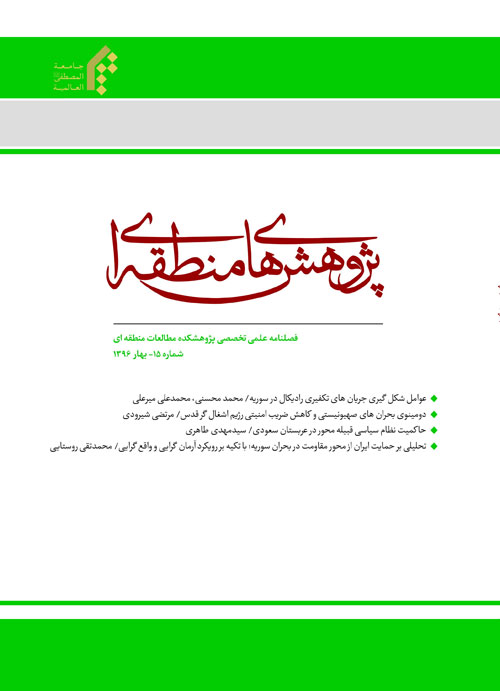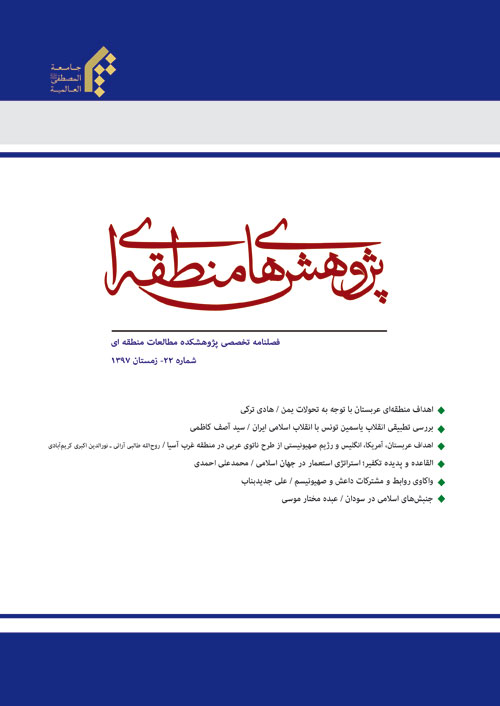فهرست مطالب

فصلنامه پژوهش های منطقه ای
سال پنجم شماره 15 (بهار 1396)
- تاریخ انتشار: 1396/04/20
- تعداد عناوین: 4
-
صفحه 7در دهه ی اخیر، حوادثی در برخی از کشورهای اسلامی رخ داد که جرقه ی آن ابتدا در سال2010م در تونس زده شد. محصول این رخداد، زایش گروه های جهادی رادیکال، به ویژه گروهک تروریستی داعش، در عراق و سوریه و در مجموع، جهان اسلام بود. این نوشتار به دنبال واکاوی علل و زمینه های داخلی و خارجی شکل گیری جریان های تکفیری با روشی اسنادی و تحلیلی است. یافته های پژوهش نشان می دهد اگر چه پیش از این، زمینه های شکل گیری جریان های تکفیری رادیکال در محیط بحران فراهم بوده، ولی صف آرایی کنشگران منطقه ای و فرامنطقه ای نیز در بروز و تشدید بحران و همچنین ظهور و شکل گیری جریان های تکفیری نقش اساسی و موثر ایفا نموده است. ظهور جریان های تکفیری، به شدت، مناسبات خارجی سوریه را در دو سطح درون منطقه ای و فرامنطقه ای تحت تاثیر قرار داده و زمینه را برای منازعات و واگرایی روابط خارجی این کشور فراهم نموده است.
کلیدواژه ها
کلیدواژگان: جریان، جهاد، رادیکال، تکفیری، داعش، سیاست، سوریه -
صفحه 25شکل گیری رژیمی بر پایه اندیشه جعلی صهیونیستی و نداوم آن در سرزمین فلسطین اشغالی، همچنان مهم ترین چالش جهان اسلام است (مساله) اما چرا این رژیم براساس پیش بینی مقام معظم رهبری تا بیست سال دیگر از بین خواهد رفت؟ (سئوال) علت فروپاشی رژیم اشغال گر قدس طی دو دهه آینده به بحران های تاریخی،سیاسی و فرهنگی آن ارتباط پیدا می کند. (فرضیه) مقاله حاضر جهت آزمایش این فرضیه و دستیابی به پاسخ پرسش پیش گفته (هدف) ، روشی توصیفی-تحلیلی بر بستر تاریخ را پیش روی خود دارد. (روش) بحران های این رژیم از درون و از دو ناحیه انتفاضه مستمر (درون-فلسطینی) و پدیده پساصهیونیسم (درون-یهودی) به سقوط رژیمی می انجامد که تاکنون براساس حمایت های استعماری و نه توان داخلی، باقی مانده است. این بحران ها هم اینک، به چنان شدت و حدتی رسیده که برای رفع یا حل آن،سفارت آمریکا را به قدس شریف منتقل کرده اند اما این اقدام آغاز سقوط بیست ساله اسرائیل غاصب را نوید می دهد. (یافته)
-
صفحه 43درک نظام سیاسی یا الگوی سازمان بندی قدرت در جوامع، منوط به شناخت قدرت و ساختار سیاسی در هر کشور است و در این خصوص، همواره، اندیشمندان الگوهای متفاوتی به منظور تحلیل نظام های موجود در کشورهای جهان ارائه کرده اند.
نظام سیاسی عربستان سعودی، مطابق استانداردهای رایج در علوم سیاسی، در قالب پادشاهی موروثی و مطلقه تعریف شده و افزون بر این، یکی از ویژگی های متمایز این کشور در مقایسه با دیگر حکومت های مشابه، آن است که قبیله ای از سال 1932م تاکنون، محور قدرت در این کشور قلمداد شده است و خاندان آل سعود، به صورت رسمی بر همه ی عرصه های قدرت در عربستان مسلط است.
از آن جایی که شناخت دقیق نظام سیاسی و پویش های درونی حاکم بر عربستان به عنوان یکی از کشورهای مهم خاورمیانه و جهان اسلام بسیار حائز اهمیت است، نگارنده درصدد است بررسی کند که در این نظام سیاسی مبتنی بر پادشاهی موروثی و مطلقه، چگونه خاندان آل سعود با تکیه بر عنصر قبیله در این کشور حکمرانی می کنند؟
کلیدواژگان: نظام سیاسی، قبیله ی آل سعود و پادشاهی عربستان سعودی -
صفحه 69روابط سیاسی ایران و سوریه به عنوان دو کشور راهبردی در خاورمیانه، حداقل پیشینه ای به بلندای عمر انقلاب اسلامی ایران دارد. از زمان پیروزی انقلاب تاکنون، پژوهش های بسیاری درباره ی تعاملات این دو کشور انجام شده است. این تعاملات و مناسبات با شکل گیری بهار عربی و تشدید بحران در سوریه به اوج رسیده و پرسشی با مضمون «دلایل حمایت ایران از محور مقاومت در بحران سوریه چیست؟» ایجاد کرده است. به نظر می رسد ایران در گام نخست، به دنبال اهداف ایدئولوژیک و مذهبی و سپس در پی حفظ منافع ملی خویش باشد. این پژوهش به دنبال واکاوی دقیق و کاربردی اهداف و رویکردهای ایران در حمایت از «محور مقاومت» در قبال بحران سوریه است و در نظر دارد، با استفاده از روش توصیفی- تحلیلی به این هدف دست یازد. بررسی های پژوهش نشان می دهد جمهوری اسلامی ایران با ایجاد توازن بین عناصر آرمان گرایی و واقع گرایی و با تلفیق دو رویکرد ایده آلیسم و رئالیسم، به دنبال حفظ محور مقاومت اسلامی، کاهش نفوذ امریکا و اسرائیل در منطقه، مشارکت فعال در تثبیت نظم های سیاسی- امنیتی خاورمیانه و سرانجام، دفاع از امنیت منافع ملی است.کلیدواژگان: ایران، سوریه، سیاست خارجی، محور مقاومت، آرمان گرایی، واقع گرایی
-
Page 7
In the last decade, some events happened in some Islamic countries that it sparked first in 2010 in Tunisia. The result of this incident was the birth of radical jihadi groups, especially the ISIS terrorist group, in Iraq and Syria, and in general, the Islamic world. This paper seeks to analyze the causes and the internal and external fields of the formation of Takfiri processes in a documentary and analytical method. The findings of the research show although the conditions for the formation of radical Takfiri processes have been provided in the crisis environment, but the alignment of regional and sub-regional actors has also played a significant and critical role in the appearance and intensification of the crisis and also the appearance and formation of Takfiri processes. The appearance of Takfiri processes has severely affected the foreign relations of Syria at two levels of regional and sub-regional and has provided a platform for conflicts and divergence in its foreign relations.Keywords: process, Jihad, Radical, Takfiri, ISIS, Politics, Syria -
Page 25The formation of a regime based on the fake Zionist thought and its continuity in Occupied Palestinian Territory is still the most important challenge of the Islamic world. (Problem) But why this regime, according to the Supreme Leader's prediction, will be gone for another twenty years? (Question) The cause of the collapse of occupier regime of Quds will be linked to its historical, political and cultural crises over the next two decades. (Hypothesis) The present article, in order to test this hypothesis and to achieve the answer of the above question (objective), has a descriptive-analytic approach to the context of history. The crises of this regime from inside and two regions of the continuous Intifada (inside Palestine) and Post-Zionist phenomenon (inside the Jew) lead to a regime's collapse, which has so far remained based on colonial protections and not internal power. Now, these crises have received to such intensity and severity that they to removal or resolve
them have transferred the US Embassy to Quds Sharif, but this move marks the beginning of the 20-year-old fall of the Israeli usurper. (Found) -
Page 43Understanding the political system or the pattern of power organization in societies depends on recognition of the power and political structure of each country, and in this regard, scholars have always offered different patterns in order to analysis the existing systems in the countries of the world. The Saudi political system, in accordance with the common standards in political science, is defined in the form of a hereditary and divine monarchy, and moreover, one of the distinctive features of this country in comparison with other similar governments is that the tribe has been considered of power since 1932 to now, and the Al Saud family is officially dominant in all areas of power in Saudi Arabia. Since the exact understanding of the political system and internal dynamics governing Saudi Arabia as one of the major countries of the Middle East and the Muslim world is very important, the author seeks to explore in this political system based on hereditary and divine monarchy, how does the Al-Saud family reign relying on the tribal element in this country?Keywords: political system, al-Saud tribe, kingdom of Saudi Arabia
-
Page 69Political relations between Iran and Syria, as two strategic countries in the Middle East, have at least a long history of the lifetime of the Islamic revolution of Iran. Since the revolution's victory, so far, many researches have been conducted about the interactions between the two countries. These interactions and relationships have peaked with the formation of the Arab Spring and the escalation of the crisis in Syria and created a question with content "What are the reasons behind Iran's protection for the resistance axis in the Syrian crisis?" Iran seems to be in the first step pursuing ideological and religious goals and then seeking to preserve its national interests. This research seeks to accurate and functional analysis Iran's goals and approaches in protection of the "resistance axis" towards the Syrian crisis, and intends to reach this goal out with using descriptive-analytical method. Research studies show that the Islamic Republic of Iran by balancing elements of idealism and realism by combining two ideological and realism approaches, seeking to maintain Islamic resistance axis, reduce the influence of the United States and Israel in the region, active participation in the consolidation of the Middle East political and security order and finally, defending the security of national interests.Keywords: Iran, Syria, foreign policy, resistance axis, idealism, realism


